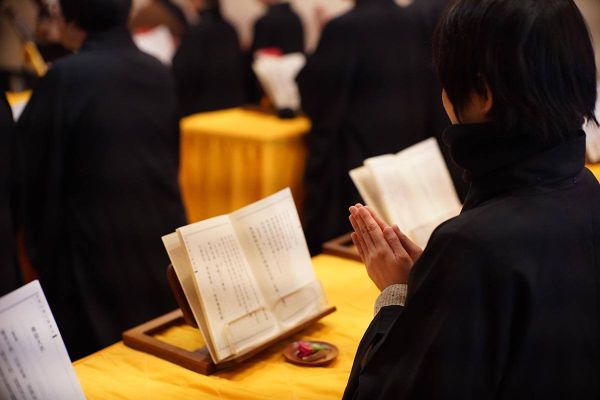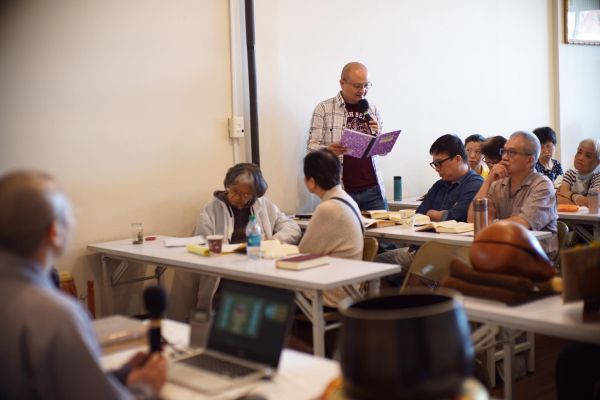Special Topics
Common Ways to Study and Practice Sutras
Receive and Uphold, Read and Recite
 Receive and Uphold (受持) means that we accept the concepts and views of Buddhadharma, never forgetting the teachings of the Buddha and Bodhisattvas once we hear them. Uphold (持, Chih) means "remember and never forget." For example, upholding the precepts means to behave in accordance with the precepts after taking refuge in the Three Jewels and receiving the Five Precepts. In Buddhist scriptures, "read" means to read silently to oneself, while "recite" means to read aloud a memorized text.
Receive and Uphold (受持) means that we accept the concepts and views of Buddhadharma, never forgetting the teachings of the Buddha and Bodhisattvas once we hear them. Uphold (持, Chih) means "remember and never forget." For example, upholding the precepts means to behave in accordance with the precepts after taking refuge in the Three Jewels and receiving the Five Precepts. In Buddhist scriptures, "read" means to read silently to oneself, while "recite" means to read aloud a memorized text. Buddhists place great emphasis on receiving, upholding, and reciting classic scriptures. The act of receiving and upholding sutras demonstrates that practitioners have already developed faith in the Dharma discussed in the sutras; otherwise, they would not have been so willing to accept and memorize these teachings. Reading a sutra is like watching yourself in a mirror. We can use the wisdom and meaning in the sutra to examine our behaviors and thoughts, which can thereby help us benefit from our practice. To recite sutras is to bear their contents in mind so that we can use the Dharma whenever and wherever we need it, applying it to all aspects of our daily life. In so reciting, we can share the sutras as well as pass them down to others.”
 Prostrate
Prostrate
To prostrate to a sutra entails initially reading the title of the sutra and prostrating, followed by prostrating word for word up to the end of the sutra. The purpose is not to understand the content of the sutra, but to worship the Bodhisattvas, Arhats, and Dharmapala (Dharma protectors) mentioned in the sutra who were present in the assembly to whom the Buddha was expounding the Dharma,
Explain
To "explain" means to share with others the ideas found in the sutras. There are three ways to explain the sutra: firstly, to use language to communicate others about the meaning of the sutras; secondly, to explain sutras through written words; and, thirdly, to present the Dharma or contents of a sutra through music, dance, paintings, sculptures, or other kinds of presentation or performance. People in the modern world use language, sounds, images, and pictures--- by means of media and technology, such as television, radio, the internet, newspaper, magazines, and billboards-- to promote the meaning of scriptures. These can also be considered methods used to explain sutras.
Chaojing
 Respectfully and attentively taking a pen to copy the scriptures is known as "Chaojing", and has two functions. The first is to help us memorize the scriptures, since making one copy is more effective than reading it ten times. The second is to cultivate a feeling of respect toward the scripture: for instance, before we start copying, it would be best to wash our hands, burn incense, and prostrate three times. It is because we read the sutras that we see the Dharma; and as we see the Dharma, we meet with the Buddha. Hence, copying sutras is equivalent to hearing the Dharma directly from the Buddha. If we copy sutras mindfully, then copying itself becomes a method of meditation.
Respectfully and attentively taking a pen to copy the scriptures is known as "Chaojing", and has two functions. The first is to help us memorize the scriptures, since making one copy is more effective than reading it ten times. The second is to cultivate a feeling of respect toward the scripture: for instance, before we start copying, it would be best to wash our hands, burn incense, and prostrate three times. It is because we read the sutras that we see the Dharma; and as we see the Dharma, we meet with the Buddha. Hence, copying sutras is equivalent to hearing the Dharma directly from the Buddha. If we copy sutras mindfully, then copying itself becomes a method of meditation.The copied scriptures can be kept as a souvenir. If the handwriting is beautiful, we can share it with others to form positive connections; otherwise, we can burn it or recycle it after prostration.
Resource:
The Exquisite Dharma: Commentary on Lotus Sutra (絕妙說法:法華經講要), Dharma Drum Publishing Corporation
